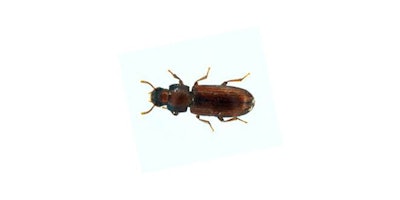
 Pari Pachamuthu, Technical Director, Rentokil Steritech
Pari Pachamuthu, Technical Director, Rentokil SteritechFor food manufacturers, stored product pests (SPP) rank high on the list of most expensive potential problems. SPP, also commonly referred to as stored product insects, are recognized as the most common type of pests in food manufacturing facilities. These include several types of insects of both the flying and crawling varieties such as moths, beetles and, though less common, weevils.
Food manufacturers that suffer a SPP infestation can lose up to 10 percent of their revenue for the year. These high costs are the results of lost product, potential interruption to business operations and potential fines. Additionally, ensuring an infestation is under control often requires deep cleaning inside the equipment, which can be both time consuming and costly. Because the cost is so high, it’s important to have a thorough plan in place for prevention, detection and treatment of SPP.
Prevention
An effective integrated pest management (IPM) program is essential for keeping food manufacturing facilities clear of SPP infestations.
It starts with several practices the staff of the facility can put in place, including thorough inspection of incoming products before they enter the facility. Keeping the bugs out in the first place is the best way to stop them from contaminating products throughout the manufacturing process. It’s also imperative to have a meticulous sanitation program in place — cleaning up spillage and regularly performing intensive cleaning of manufacturing equipment will reduce the opportunities for SPP to feed and breed.
Another key element of a good IPM for food manufacturing facilities is to integrate a good “first in, first out” system, using the oldest product in the inventory first to keep materials rotating through before bugs have a chance to infest. Your pest management partner also plays an important role here, inspecting the building to ensure there are tight seals on doorways, screens over openings in the ventilation system that can potentially act as entry points and looking out for other factors both inside and outside the facility that can put it at risk for SPP infestation.
Detection
Even with an excellent IPM in place, constant vigilance is necessary to put a stop to small SPP problems before they grow into full infestations.
SPP typically target products such as cereal grains, nuts, preserved or dried meat and fruit, spices and cheese. Storage areas should be monitored constantly for signs of a SPP problem. Common signs of infestation include:
- Damage to food or its packaging
- The presence of the bugs themselves (live or dead)
- Eggs and larvae or pupae and silk webbing on storage bins, shelving or other surfaces in and around the storage area.
The small size of most SPP makes them difficult to detect, even by trained eyes. Staff must thoroughly examine all incoming and outgoing products for signs of infestation and should remain vigilant for spillage and the presence of old products in the facility.
Managers of food manufacturing facilities are strongly recommended to have a trained pest management professional conduct regular inspections, as they will have a better idea of what to look for. Your pest management company can also install pheromone traps in a grid pattern throughout the facility to not only monitor for the early signs of a problem, but also to pinpoint specific areas where the problem is taking root. These trained professionals will also be able to assess conditions in your facility and know specific areas for routine inspections, even when there are no obvious signs of an infestation.
Treatment
Even with rigorous prevention practices and regular inspections, it is still impossible to completely eliminate the risk of SPP from a food manufacturing facility. Where there are stored food products, SPP will appear, so the real goals are to minimize the threat and tackle potential problems early, before they become full-blown infestations.
When the signs of a potential problem do appear, it’s important to contact your pest management partner right away, but there are also a few things staff members can do to contain the risk in the meantime. It is crucial to sanitize thoroughly around the infested area, cleaning up any spillage that might harbor pests. One thing staff shouldn’t do is move the infested products to other parts of the building, as this increases the risk of spreading the problem further.
Your pest management partner will be able to treat the problem through a combination of crack/crevice, spot and space treatment. Space treatment generally involves fogging with pesticides that do not leave residue behind, which allows the facility to get back up and running quickly. For more severe problems, fumigation may be necessary, and in large facilities that are particularly prone to SPP infestations, it may be necessary to conduct one or two routine, scheduled fumigations each year. Most facilities, however, can reduce the need for scheduled fumigation by improving their sanitation program. In some cases, pest management professionals can treat an infestation without using pesticides by isolating the affected product and using heat to eliminate the bugs, potentially salvaging some of the product that was not badly damaged.
For companies in the food manufacturing industry, SPP are part of the cost of doing business, but vigilance and attentive prevention practices can help keep that cost under control. Partnering with skilled pest management professionals helps you mitigate that risk and catch potential problems early, when treatment is less expensive. These elements come together to form a strong IPM program that will help keep your facility up and running and reduce the costs of lost time and lost products.
Pari Pachamuthu is a board-certified entomologist and the technical director for Rentokil Steritech’s Central Market. He is an expert in detecting and treating stored product pests in food manufacturing facilities and other commercial settings.






















